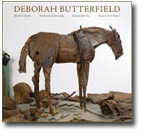Books |
Deborah Butterfield
By
Published: Jan 01, 2007
Category:
Art and Photography
Deborah Butterfield
By Robert Gordon
Here’s how much I don’t come from the equestrian set: My Russian immigrant grandmother thought “Mr. Ed” — a 1950s TV series about a talking horse — really was a talking horse. “Vy else,” she would say, “vould he be on TV?”
So I find nothing more disconcerting than the sight of a horse in the city. Along Central Park South, the horse-drawn carriages are lined up, waiting for tourists or lovers. To inexperienced and cynical old me, they’re a reminder of Olde New York, or London, or Paris — they take me back to Black Beauty and that heart-stopping sex scene in a carriage, rocketing through town, in ‘Madame Bovary.’
Even stranger to me: horses on the paths in Central Park. You’re walking along Fifth Avenue in the late afternoon, and as you look West to the setting sun, you see the silhouette of a lone rider. It’s like a shot from a Bergman movie; you’re too knocked out by the image to contemplate what it might be like to be that rider.
In the West, it’s a different story. Every few years, we make a pilgrimage to the HF Bar Ranch in Wyoming so we can reconnect with our more natural selves. It’s a different world astride a horse; your brain opens in new and unexpected ways.
Deborah Butterefield’s sculptures of horses have the same effect. Not for her the bronzes of Frederick Remington, who saw horses as active partners of active men. Her horses are….themselves. Individuals. With distinct personalities. And great souls. If you love animals, these will steal your affection as surely as if they were great cats or dogs.
What’s surprising about Butterfield’s horses is their construction. She began by making them of sticks, wire and mud. (And by building them big — they’re taller than most horses.) From the beginning, she could use these unpromising materials to deliver the essence of a horse. What she could not deliver was permanence. So she learned to use disposable materials as the mold of the sculpture, and then to cast it in bronze that retained the texture of wood, wire and mud. Careful painting completes the work.
Butterfield breaks fresh ground with every horse. And why not? She thinks of her sculptures as self-portraits — as explorations of her animal nature. Maybe that’s why so many of her sculptures seem to be female. And why they connect on such a deeply emotional level.
This beautiful book contains 75 full-color plates. It is the ideal gift for horse lovers — and that includes girls who are mad for horses and are ready to dream about them in a new way. But even considered just as a coffee-table book, ‘Deborah Butterfield’ passes every test, starting with the shallowest — your guests will gravitate to it, flip through it, and say, “Where did you get this?”
To buy ‘Deborah Butterfield’ from Amazon.com, click here.


